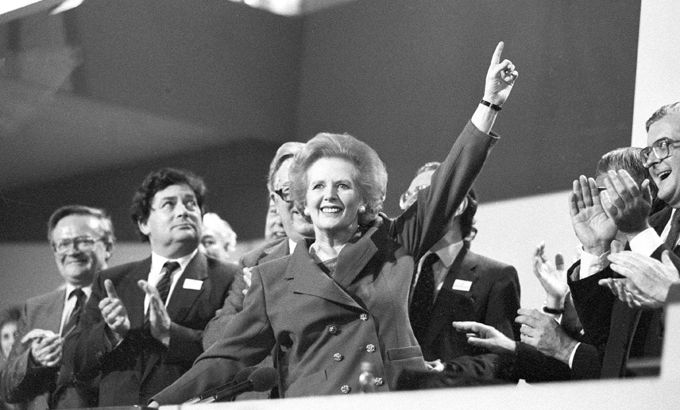‘Iron Lady’ emerged as conservative icon
Daughter of a grocer, Thatcher studied chemistry at Oxford before becoming the first woman to be elected as PM.

Margaret Hilda Thatcher, who died on Monday after suffering a stroke, was arguably the most recognisable British politician since Winston Churchill.
Thatcher became prime minister in 1979, the first woman ever to be elected to the position.
She held power until 1990, winning three consecutive elections as leader of the Conservative party, and was appointed to the House of Lords, as Baroness Thatcher of Kesteven in 1992.
Thatcher was advised to stop public speaking on health grounds shortly before the death of Sir Denis Thatcher, her husband, in 2003. In her final years, she struggled with dementia.
In 2007, she became the first British prime minister to be honoured with a statue in the Houses of Parliament while still alive.
Grocer’s daughter
Thatcher, née Roberts, was born in Grantham in Lincolnshire on October 13, 1925, the daughter of a grocer.
After attending Grantham Girls’ School she went to Oxford University where she studied natural sciences and specialised in chemistry. She became president of the the university’s Conservative Association in 1946.
In 1951 she married Denis Thatcher, a wealthy divorced businessman, with whom she was to have two children.
After a tough campaign she was elected as member of parliament for Finchley, in north London, in 1953 and became education secretary under Edward Heath after he won the 1970 general election.
Thatcher defeated Heath for the leadership of the Conservative Party in 1975 and became prime minister in 1979.
Arriving at 10 Downing Street, amid mounting industrial action by the country’s unions, she famously said, in a paraphrase of St Francis of Assisi:
“Where there is discord, may we bring harmony. Where there is error, may we bring truth. Where there is doubt, may we bring faith. And where there is despair, may we bring hope.”
Falkland’s factor
Thatcher’s political philosophy, which later became known as Thatcherism, involved less state intervention and a commitment to free markets and entrepreneurialism.
 |
| Thatcher was a close ally and friend of late US president Ronald Reagan [Reuters] |
As her government began to introduce its policies, including reduced expenditures on services such as education and housing, unemployment rose sharply.
By December 1981, Thatcher’s job approval rating had fallen to 25 percent, the lowest of her entire premiership.
In April 1982, Argentina invaded the British held Falkland Islands. After a short bloody war, the islands were recaptured.
The conflict helped boost Conservative support and the party won a landslide victory in the June 1983 general election, taking an overall majority of 144 seats.
Although strengthened by the election result, Thatcher’s government found itself the following year challenged by a strike by Britain’s coalminers.
Miners’ strike
Thatcher was determined to lessen the power of the trade unions which she saw as holding the country to ransom. The strike turned into a violent and bitter dispute which split the country.
Eventually, after a year on strike, the National Union of Miners conceded without a deal.
Following the action, the unions went into steep decline, losing much of their power, rights and influence as well as millions of members.
Thatcher had long been a target for the Irish Republican Army which was waging a violent campaign for a united Ireland.
In October 1984, a hotel she was staying in was bombed by the IRA in a clear attempt to kill her and her cabinet.
Thatcher, who was in Brighton for the Conservative party conference, delivered her speech as planned in defiance of the bombers.
‘Iron lady’
On the international stage, Thatcher wooed and bullied in equal measure.
Francois Mitterand, the late French president, famously described her as having “the eyes of Caligula and the mouth of Marilyn Monroe”.
She faced fierce criticism over her opposition to economic sanctions over South Africa’s apartheid regime.
At the height of the Cold War, Thatcher described Mikhail Gorbachev, the then Soviet leader, as a man she could do business with.
But it was with Ronald Reagan, the US president and her political soulmate, that she developed a special bond.
She backed Reagan’s policy of deterrence against the Soviet Union, causing friction with allies who still adhered to the idea of détente that had been followed in the 1970s.
The Soviets described her as the “Iron Lady” – a tag she relished.
Her supporters credit her stance as playing a part in the eventual collapse of the Soviet Union in 1991.
Fundamental change
In 1987, Thatcher led her party to a third term in power with a 102 seat majority, becoming the longest continuously serving prime minister of Britain since Lord Liverpool in 1812 to 1827.
However, controversial policies including the poll tax, which appeared to shift the tax burden from rich to poor, and her increasingly strident opposition to any closer integration with Europe, began to lose her support both in the country and in her party.
In November 1990, Michael Heseltine, who had resigned from Thatcher’s government in 1986, challenged her for the leadership of the party.
Heseltine narrowly received enough backing from the parliamentary Conservative party in the first round of voting to take the contest to a second ballot.
Although Thatcher initially stated that she would contest the second ballot, she resigned after consulting with her cabinet colleagues and left Downing Street for good.
Thatcher’s final years were dogged by ill health and a series of minor strokes meant she rarely spoke in public.
But critics and supporters alike would accept that she helped create a period of fundamental change, not just in Britain but across the world.